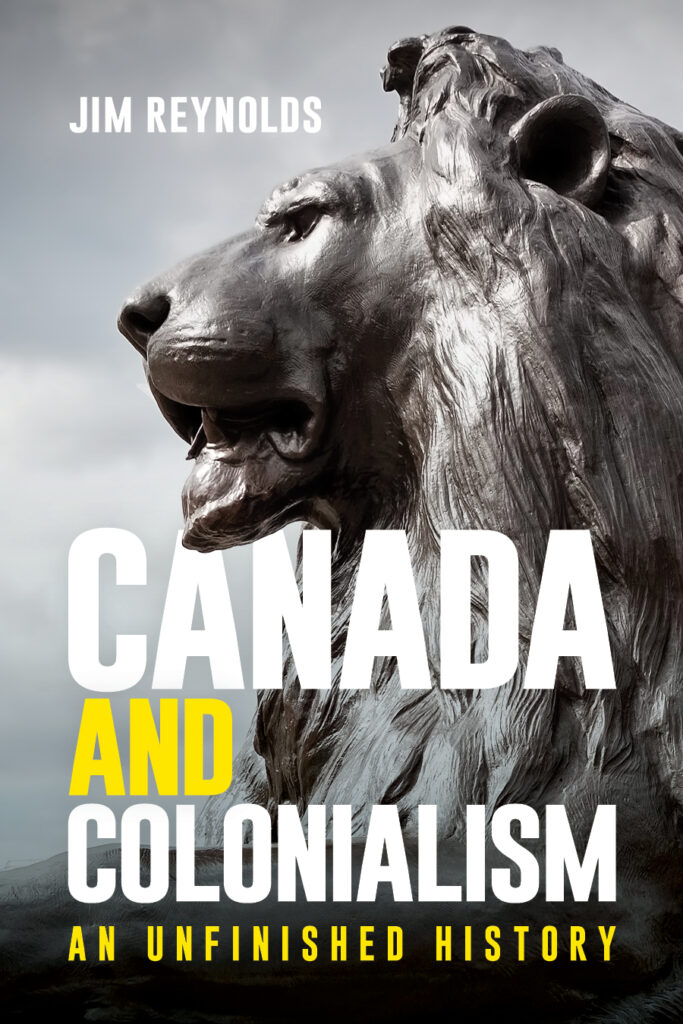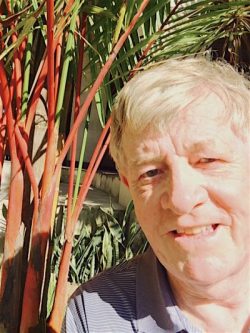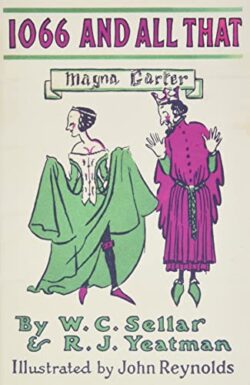Indigenous law and Canadian history
Canada and Colonialism: An Unfinished History
by Jim Reynolds
Vancouver: Purich Books, 2024
$32.95 / 9780774880947
Reviewed by Robin Fisher
*

Early in my academic career I had a colleague who, when his office phone rang, would pick up and greet the caller by saying, in an impeccable Indo-English accent, “British Empire.” It was all a bit of a lark at a time when historians still had fun. After reading his book, Canada and Colonialism: An Unfinished History, I am sure that Jim Reynolds would have been, as someone once said, “not amused.”
Reynolds’ book is a general history of the British Empire, Canada’s role in it, and the impact on the cultures and lives of Indigenous people both then and now. He defines colonialism as “a process that results in the control of one people’s territory by another.” That colonialism, derived from the British Empire and embraced by Canadians, is deep-seated in our history. So, Reynolds does not let Canada off the hook. Many English Canadians were ardent imperialists who had careers in Canada and throughout the wider Empire. As Canada gained increasing measures of independence from Britain, it maintained the imperial model and established a system of internal colonialism. Thus, when it came to pass, self-government was for settlers and not extended to Indigenous people who remain, to this day, colonised subjects.
Reynolds wrote this book because of a long career as a lawyer arguing for Indigenous rights in the courts. He points particularly to his involvement in the case in which the Musqueam sought redress for the federal government’s irresponsible lease in the 1950s of their reserve land on Point Grey to a golf and country club. Why, he asks, did the Musqueam have no say in this allocation of their land at a time when they did not even have the right to vote? It was, as we will learn, only one example of many. Even when Indigenous rights began to be defined in the courts of British Columbia, those concessions were limited and restricted. Reynolds wrote this book because we all live with the history of the British Empire and “the shadow that it casts over the relationship between Indigenous and non-Indigenous people.” The British Empire is the evil empire.
In the councils of some First Nations people there is a protocol whereby, before you take issue with a speaker, you must state first their case to their satisfaction. I hope that I have done that. I should also say that Reynolds’ book conveys a message that Canadians should hear and act upon. Reynolds is a lawyer trained to make a case whereas I, for my sins, am an historian trained to think about the play between nuance and generalisation.

As he builds his case, Reynolds likes to present what I will call quote piles. He makes a point and then follows up with a series of quotations from others to support it. There are many from those who knew what they are talking about: advocates of imperialism like Lord Milner, Duncan Campbell Scott, or Winston Churchill. Some from those who thought that they knew what they were talking about like Gilbert and Sullivan or Stephen Leacock. And some from the likes of George Woodcock who knew everything that he himself ever wrote. They are all witnesses for the prosecution even when that was not their intent. All were bad actors in the British Empire which itself was, to quote 1066 And All That, a “Bad Thing.” Reynolds makes a strong case for that view. But there are no witnesses for the defence and nor, for Reynolds, is any defence possible.1
The trouble is, the British Empire was so vast and diverse that, as some have said about The Bible, you can always find something that will prove your point. Along with many historians, Reynolds divides British colonies into two basic types: colonies of settlement, where newcomers came and took over Indigenous land and became the majority, and colonies of dependence, where the interlopers formed an administrative-military strata that remained a small minority but supervised the exploitation of resources using Indigenous labour. Canada was both at different times in its history but Reynolds does not comment on the imperialism of the fur trade and only looks at the settlement phase. Having made this distinction, Reynolds then proceeds to compare Canada to colonies of exploitation in Africa and particularly to India, that are most unlike Canada, rather than colonies of settlement, say, Australia or New Zealand, that are much more like Canada. This approach leads to a bind to which I will come back.

According to Reynolds, there are no mitigating factors about the British Empire whose representatives are bent on the subjugation of Indigenous peoples. There is no mention of those who, though unsuccessfully, tried to make things better for First Nations people, like James Douglas or Gilbert Malcolm Sproat. The colonist Sproat is only quoted in his earlier Scenes and Studies of Savage Life stage with no mention of his later advocacy for Indigenous rights as Reserve Commissioner. The idea that agents of imperialism might learn from experience and change their tune does not come up in this book. All treaties with Indigenous people are bogus but there is no mention of the Treaty of Waitangi which had a nobler purpose and would eventually become the basis for the assertion of Māori claims. Counter currents and nuance are not a part of this story of Empire but they are interesting to the historian because back eddies can later become mainstream.
So, let’s just take one example: the career of George Grey who was successively governor of South Australia, New Zealand, then the Cape Colony, New Zealand again, though less successfully the second time, and, lastly, Prime Minister of New Zealand. Grey had a long career in the colonial service with some successes, particularly with protecting Māori interests, and certainly many failures. He used military force against Indigenous people in both South Africa and New Zealand. Reynolds has found a source that asserts he has “been described as the founder of apartheid in South Africa.” This he apparently achieved one hundred years before the National Party came to power in 1948 and implemented apartheid. Grey’s objective was apparently the destruction of indigenous cultures even though his Polynesian Mythology as told by Māori leaders and published in both languages became a classic.2 He was a man of mana among many Māori. If Reynolds had absorbed Keith Sinclair’s biographical sketch of George Grey, rather than simply citing it, he might have understood how, like most of us, George Grey was a very mixed figure.3 But when everything is black and white there can be no shades of grey.

Nothing good ever came from the British Empire. Reynolds considers that possibility in a few paragraphs at the beginning of his conclusion only to reject it. Even cricket is disparaged. That elegant game so replete with irony the greatest of which is that the ex-colonials are often better at it than the Brits. I think that Reynolds might agree with me, as a generalisation if not the particular example of cricket, that the ultimate power of imperialism is when the colonials become better at it than the mother country.
Even if you can accept a more nuanced view of British and Canadian imperialism there can be no doubt of its disastrous impact on Indigenous peoples. So, what to do about overturning the history of colonialism in Canada? Here the comparison of Canada with India and Africa becomes a blind alley. Decolonisation is possible in colonies of exploitation when the colonists take their leave and go back home. Decolonisation is much more complicated in colonies of settlement, like Canada, when the definition of colonialism is taking territory and where the newcomers are here to stay. Here a fuller comparison with the recent history of New Zealand, a somewhat more positive example, and Australia, not so much, would be helpful. Rights and land can be restored but it is a complex process and it takes time and effort to get beyond partial solutions.
For Canada, Reynolds solution is, first, to remove all remaining statues of John A. Macdonald along with the names of places, like Tweedsmuir Park, that have imperial echoes. I have already commented on the value of statue removal in The British Columbia Review so will not go there again. Reynolds calls for more education about the history of colonialism in schools and universities, which is fair enough, although Canadian historians have been writing on the subject for, oh, about fifty years. Beyond these fairly straightforward antidotes the going gets much more difficult. Reynolds fundamental solution to the effects of colonialism is for Indigenous people to have self-determination as they now do in India. But what is needed, having said that, is discussion of how sovereign First Nations would be self-determining within a sovereign Canada? How would that arrangement work when interests clash? Or was Wilson Duff closer to the mark when he wrote in 1964 that First Nations people “should always retain the right to find their own identity and develop their own lives as they wish within the framework of Canadian society.”4 That is the big question that we face as we contemplate what Reynolds correctly calls “an unfinished history.”
This history of the British and Canadian imperialism reflects our age. It is as one dimensional as the nineteenth century view of empire. It is just a different dimension. It really is such a pity that the imperialists of 200 years ago did not have the foresight to think like us. But, having said that, where do we go from here?
*

Robin Fisher taught and wrote history as a faculty member at Simon Fraser University before he moved into university administration and contributed to the establishment of two new universities: the University of Northern British Columbia in Prince George and Mount Royal University in Calgary. His books include Contact and Conflict: Indian-European Relations in British Columbia, 1774-1890 (UBC Press, 1977; second edition, 1992) and Duff Pattullo of British Columbia (University of Toronto Press, 1991). He was the 2022 Lieutenant Governor’s Medal for Historical Writing for Wilson Duff: Coming Back, A Life. [Editor’s note: Robin Fisher has reviewed books by Daniel Marshall, Margaret Horsfield & Ian Kennedy, Gordon Miller, Art Downs, Richard Boyer, William Frame & Laura Walker for The British Columbia Review, and contributed two popular essays, The Way We Were: Two Friends, Two Historians and “The Noise of Time” and the Removal of History? ]
*
The British Columbia Review
Interim Editors, 2023-25: Trevor Marc Hughes (non-fiction), Brett Josef Grubisic (fiction)
Publisher: Richard Mackie
Formerly The Ormsby Review, The British Columbia Review is an on-line book review and journal service for BC writers and readers. The Advisory Board now consists of Jean Barman, Wade Davis, Robin Fisher, Barry Gough, Hugh Johnston, Kathy Mezei, Patricia Roy, Maria Tippett, and Graeme Wynn. Provincial Government Patron (since September 2018): Creative BC. Honorary Patron: Yosef Wosk. Scholarly Patron: SFU Graduate Liberal Studies. The British Columbia Review was founded in 2016 by Richard Mackie and Alan Twigg.
“Only connect.” – E.M. Forster
*
- W.C. Seller and R.J. Yeatman, 1066 And All That (Harmondworth: Penguin, 1960), p.47 ↩︎
- The Dictionary of New Zealand Biography (Wellington: Allen & Unwin/Department of Internal Affairs, 1990) pp. 160-164; another version is in A. H. McLintock, An Encyclopaedia of New Zealand, vol.1 (Wellington: Government Printer, 1966) pp. 877-880 and also https://teara.govt.nz/en/biographies/1g21/grey-george. ↩︎
- Sir George Grey, Polynesian Mythology and Ancient Traditional History of the Maori as Told by their Priests and Chiefs (Christchurch etc.: Whitcombe and Tombs, 1965) originally published in Māori in 1854 and English a year later. ↩︎
- Wilson Duff, The Indian History of British Columbia Volume 1 The Impact of the White Man (Victoria: Provincial Museum of Natural History and Anthropology, 1964), p.107. ↩︎
2 comments on “Indigenous law and Canadian history”
Reply to Review by Robin Fisher from the author.
I welcome the review by Prof. Fisher and thank him for taking the time to read the book and write the review. I especially welcome his comment that “Reynolds’ book conveys a message that Canadians should hear and act upon.” Like anyone else who has followed an interest in Indigenous matters and British Columbia, I have benefitted from and admired his work for many years.
He is critical of the book and I would like to take this opportunity to briefly reply in the hope that readers of the review may take my comments into account and, indeed, read the book and come to their own conclusion.
I have quoted below some of his comments and my responses:
1. “There are no witnesses for the defence and nor, for Reynolds, is any defence possible. … According to Reynolds, there are no mitigating factors about the British Empire. … Nothing good ever came from the British Empire. Even cricket is disparaged.”
With respect, this does not do justice to the discussion in the book about the justifications for colonialism advanced at the time, principally the civilizing mission (pages 29-47), nor the discussion of the balance sheet approach listing the supposed credits and debits of the British Empire in the conclusion (pages 227-230). This approach has provoked much disagreement in the bulging literature from the United Kingdom which I reference. Those references include benefits as listed by prominent colonial officials like Frederick Lugard and Alan Burns as well as recent academic support from Niall Ferguson, Jeremy Black, Nigel Biggar and Canadian scholar, Bruce Gilley. (Gilley’s most recent book, The Case for Colonialism, was published too late for inclusion). Readers are encouraged to read those works as well as those from authors, including myself, who are unconvinced that a system of taking control of the lands and lives of peoples of another society based on a belief in racial and/or cultural supremacy, and using force as necessary can be justified. Such a predatory, hierarchical world order is systematically immoral.
So far as cricket is concerned, it is mentioned only once as one benefit included by one colonial administrator (page 227). I do not “disparage” it and rather enjoy watching it.
2. “There is no mention of those who, though unsuccessfully, tried to make things better for First Nations people, like James Douglas or Gilbert Malcolm Sproat. … Counter currents and nuance are not a part of this story of Empire. … So, let’s just take one example: the career of George Grey. … when everything is black and white there can be no shades of grey.”
Again, these comments overlook the references to those, like Octavian Hunt and Annie Besant in India (page 38) and James Teit in British Columbia (page 167) who could rise above the prevailing prejudices of their age to treat Indigenous peoples with compassion, curiosity, and respect. The origins of the humanitarian movement is discussed and described as worthy and sincere although leading to the civilization mission as a justification for colonialism (pages 40-41).
It would have been interesting to enter the “counter currents” of history but, as noted by Fisher, the book in intended as a general history and space alone prevented more detailed consideration of some matters and people. I have largely been required to stay within the prevailing currents of the time.
Of course, I recognize that people are complex with shades of grey and that even ardent imperialists like George Grey could have an interest in aspects of Indigenous culture. However, this does not contradict my claim that his Report on the Best Means of Promoting the Civilization of the Aboriginal Inhabitants of Australia was a blueprint for their assimilation and the destruction of their culture which he attempted to implement in the colonies that he governed and that he influenced the forced assimilation policies of Duncan Campbell Scott, the long-serving senior Canadian Indian Affairs official (page 163). In the Report, he wrote, “I do not hesitate to assert my full conviction that, whilst those tribes that are in communication with Europeans are allowed to execute their barbarous laws and customs upon one another, so long will they remain hopelessly immersed in their present state of barbarism.” (para. 8) (https://nzetc.victoria.ac.nz/tm/scholarly/tei-TurEpit-t1-g1-t1-g1-t2-g1-t12-g1-t2.html)
3. “Reynolds fundamental solution to the effects of colonialism is for Indigenous people to have self-determination as they now do in India.”
This is the comment that I find most puzzling as it is simply wrong and contrary to one of the main points that I make in the book that “Indigenous peoples in Canada … will not become independent or decolonized in the usual sense since the descendants and successors of the French and British settlers and other immigrants are, and will remain, overwhelmingly the majority” (page 9). The Conclusion makes clear that “Decolonization in Canada cannot be the same as the process that took place decades ago for British colonies in Asia and Africa. … For the Indigenous peoples of Canada, there will be no lowering of the old flag, speeches and dances at independence celebrations, and the sailing away of the governor general.” It must be more nuanced, not black or white but a shade of grey to quote Fisher. I suggest that it is for each Indigenous group to say what “decolonization” means for them and quote a couple of Indigenous leaders who call for self-determination. This does not mean the departure of non-Indigenous people as in India. How could it? The book finishes with a quote from Jody Wilson-Raybould that it will depend on all Canadians working together (pages 232-235).
In conclusion, I would like to end on a note of agreement. Fisher writes, “But what is needed … is discussion of how sovereign First Nations would be self-determining within a sovereign Canada? How would that arrangement work when interests clash? … That is the big question that we face as we contemplate what Reynolds correctly calls “an unfinished history.”… where do we go from here?”
Fisher is correct on the need for further discussion on what self-determination would mean in the Canadian context. That is, indeed, the big question. It is not something that I set out to answer in this book which is intended only as a general history although I consider that history relevant to that discussion. I am aware of the complex issues involved, some of which I have briefly summarized in an earlier book. (Aboriginal Peoples and the Law – pages 70-72). For now, all I can say is that I agree with Wilson-Raybould that solutions will depend on all Canadians working together.
“According to Reynolds, there are no mitigating factors about the British Empire whose representatives are bent on the subjugation of Indigenous peoples.”
This bogus argument does nothing to vitiate the fact that Canada qua Canada was/is better off under the British Empire, rather than the American gold miners who invaded British Columbia and who were stopped in their tracks by Governor Douglas.
Revisionist history has a place. In the dump bin.
Polemics ain’t history, folks.